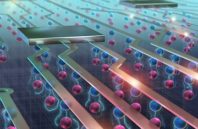A nagging efficiency bottleneck in today’s communications networks is the need to convert between the optical signals that transmit data over long distances and the electrical signals used in data processing. One potential solution lies in “excitonics”—the electrical manipulation of excitons, or electron-hole pairs, that are formed when a photon is absorbed by a semiconductor. But the excitonic devices demonstrated thus far using conventional bulk semiconductor materials have had to operate at frigid, cryogenic temperatures, a disadvantage that has held back practical applications.
Now, a Swiss-Japanese research team has used an ingenious heterostructure made of 2-D materials to fashion an excitonic transistor that allows electrical manipulation of excitons at room temperature. The prototype device, the researchers believe, could open the door to a generation of excitonic devices using 2-D materials. Those devices, in turn, could allow compact, energy-efficient optical-electronic interconnects, not only in communications but for a variety of other applications.

 (585) 768-2513
(585) 768-2513

